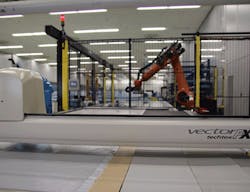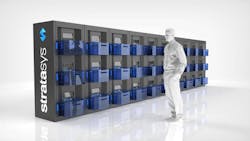There’s no question that reduction of labor can increase profits, but what areas should this occur? Currently, companies are hunting for low-hanging fruit. These low-cost solutions can be quickly and easily integrated with a current production line. More complex solutions will take time and money, which may make sense, but can be harder to sell.
This article will present some of the key factors to consider when considering return on investment (ROI) for these systems. It will also introduce several products used to reduce labor and help free up skilled workers to grow production.
Managers and executives tend to look at revenue and brass tacks. If automation equipment is brought in to replace a worker, it’s easy to simply calculate the ROI as the cost of the equipment versus the displaced worker salary. However, Universal Robots (UR) says to include the elements below for a more accurate ROI and to find the best equipment for the business.
Total Equipment Cost
There are additional fees and maintenance charges to consider. This also must include any tooling, vision systems, networking, etc. that might be needed as production changes. Workers can change without additional cost, or a marginal cost for training. Automation equipment, on the other hand, requires more money and new infrastructure. Furthermore, any maintenance and upgrades will require downtime, and possibly training for employees.
However, conversely, consider automation equipment can operate 24/7. Workers need breaks, and can only work so many shifts before they need to eat or sleep.
Total Employee Cost
Automation equipment can save on employee cost—not only due to outright replacement, but by reducing injuries. Ergonomics and proper lifting techniques are important to worker safety. In 2014, the Workplace Safety Index compiled by Liberty Mutual reported that injuries cost business around one billion dollars a week.
Finding equipment that doesn’t replace workers but increases worker up-time by reducing injuries may keep production lines flexible. In addition, if workers are overexerting themselves doing common tasks, or blindly operating in autopilot for repetitive mundane tasks, such equipment could improve production. Having to work less strenuously or avoid mundane tasks can give workers more energy to attack more complex production needs.
“Occupational health and safety issues (OH&S) in relation to manual handling processes are all too common, particularly musculoskeletal disorders (MSDs),” says UR. “With the integration of collaborative robots, these problems can be significantly reduced because workers can be freed up to work on less laborious and repetitive tasks and moved onto higher value roles within a business. It also gives workers the opportunity to learn about robot technology and to acquire new skills that will support their future growth and the growth of your business.”
Increase Efficiency
When looking at the workforce, how many resources are impacted by low-skilled labor for a given company? Many firms have mundane tasks, or “busy work,” that needs to get done. Figure out how many employees are involved with these tasks, and how long they take to accomplish. If that time could be freed with automation, it would allow those employees to do something more complex, leading to better production or the ability to give workers a needed rest. This improved efficiency and any additional production that comes from it should be considered in the ROI.
Sometimes, though, having busy work to tie together times of more complex tasks can give employees a mental break. Workers shouldn’t be running at top speed all day—that’s how accidents happen. Also, don’t assume that because you’ve freed up some employees time-wise that they will be able to produce more. Production isn’t always linear to employee availability.
Solutions
Airborne
Use of carbon fiber will likely continue to grow, what with the current trend of making things lighter and stronger. Carbon-fiber production requires a lot of manual labor, though. Today, that process is aided by automated cutters. In October, Airborne released a new machine that would essentially pick-and-place the sheet of carbon fiber from a cutter or storage system and stack them into a kit. This new machine allows workers to look up the part they need. Then it can cut and organize the sheets, and assemble them in the order the worker needs to use them.
This is Airborne’s new automating pick and place kitting machine release just last month (October 2017).
Simple pick-and-place machines, or machines that can measure and cut, can free up a lot of time. Thus, a worker could concentrate on a more complex task, or perhaps be freed to take time off to receive training for a higher skilled position.
Universal Robots
Rather than replace employees, a company could compromise by looking into collaborative robots (cobots). UR boasts about how its robotic arms are quick and easy to install, but unlike other automated equipment, can remain as flexible as the people who work with them. This can be a hard sell, since the company must consider the cost of both a robot and the worker, but in the right applications, UR has seen a lot of success.
Trelleborg Sealing Solutions in Denmark deployed 42 UR robots and was able to hire 50 more employees due to the increase in competitiveness as a result of automation.
Pick-and-place operations are some of main drivers for cobots. In one example, Voodoo Manufacturing, a 3D-printing company, had success using UR’s technology. A lot of labor can be involved in pulling out parts, replacing the build tray, and starting a new print. Voodoo employed a UR to help out, and the company tripled its output. Using the UR10, with a two-finger gripper kit from Robotiq, brought a 6-month ROI.
3D printing is on the rise, and one reason is because of its ability to automate the manufacturing process. It not only reduces labor, but companies like Voodoo are now using more automation to further the process’ market share.
Formlabs
Formlabs came out with the Form Cell, a new automated pick-and-place machine. However, a lot of the labor associated with 3D printing is also cleaning up a part, removing supports, and for the stereolithography (SLA) 3D-printing process, curing. To decrease labor as much as possible, Formlabs has a machine for cleaning and one for curing that can also be worked into the Form Cell, to create an end-to-end automation manufacturing process.
Just released, the Form Cell already uses software to reduce support materials. However, unlike the FDM process, SLA is able to nest, or stack, parts.
To illustrate, the company’s Form 2 was printing a prosthetic that cost about $52.30 per hand (about 16 parts). This included equipment ownership, materials, and manual labor. When the hand was printed in the Form Cell, cost was reduced by 41%. Most of the cost was labor-related, but the cost of ownership dropped. By using the printer 90% to 95% of the time, compared to maybe 30% when a worker is able to swap out trays, you’re increasing production and reducing the cost of ownership per part simply by boosting production.
“Moore’s Law is about predicting the future,” says David Lakatos, Formlabs chief product officer. “If you understand how the cost per part will go down, you will be able to understand what industries and applications will be impacted next.” As 3D printers become faster and engineers find new ways to design parts for 3D printing, it will certainly increase the number that signals the break-even point between new and traditional processes.
Stratasys
Stratasys has experience in manufacturing cost-effective parts, and recently teamed up with Desktop Metal to launch the Demonstrator. This is a stack of three scalable, fused-deposition-modeling (FDM) printers, one on top of the other. They print continuously by using a film of plastic that sits on top of the print bed. When a part is finished, the film slides the part out of the printer. The film is then cut, leaving a new sheet covering the print bed, and the finished part falls into a bin.
“With the nine machines we have, we can produce 1,500 parts per day,” says Mark Neilson, CEO of In’Tech.
The Stratasys Demonstrator helps increase print capacity for 3D printers. Each printer is able to communicate in real time. This machine doesn’t have to stop between parts or between jobs. The FDM also eliminates some processes, like curing, which is needed for SLA parts.
If you need to increase production, it’s simple to expand by adding more stacks. With the software, multiple jobs can print in parallel without downtime; there are no tooling changeovers; and the inventory supply chain is nearly non-existent.
“In the past, we would typically switch from 3D printing to injection molding when an order hit 300 to 400 parts. With the Continuous Build 3D Demonstrator, that number goes way up to around 1,500 to 2,000 parts,” says Rich Stump, principal and co-founder of FATHOM. “The Demonstrator allows customers to reap the time and cost benefits of repeatable and constant 3D printing. Along with the advantages of an iterative design process and free complexity, the Demonstrator makes additive a serious contender pricewise with injection molding for low-volume and bridge-to-production runs.”
While increased automation is letting 3D printing compete with injection molding on larger orders, there are limitations such as:
- The FDM process has a rougher surface finish compared to injection molding.
- Material limitation: If you need something such as ABS, you’re fine, but anything that would require certification isn’t currently supported.
- It will be increasingly difficult to find a ROI on orders over 1,500 to 2,000 parts.
These are just a few solutions that take advantage of new technology like cobots and 3D printing. Another popular technology making the most of labor cost is the industrial Internet of Things, not covered in this article. These technologies are helping to improve production and make the most of the hours that workers are on the floor.





